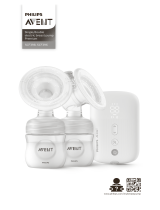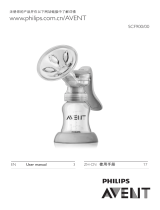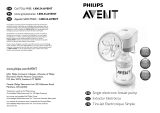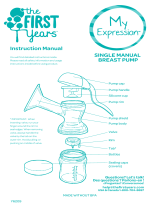
Exceptions:
- If you are expressing milk for your baby to be given in hospital.
- If your breasts are engorged (painful or swollen): you can express a small amount of milk before
or between feeds to ease the pain and to help your baby latch on more easily.
- If you have sore or cracked nipples, you may wish to express your milk until they are healed.
- If you are separated from your baby and wish to continue to breastfeed when you are reunited,
you should express your milk regularly to stimulate your milk supply.
You need to nd the optimum times of the day to express your milk, for example just before or
after your baby’s rst feed in the morning when your breasts are full, or after a feed if your baby has
not emptied both breasts. If you have returned to work, you may need to express during a break.
Using a breast pump requires practice and it may take several attempts before you succeed.
Fortunately, the Philips AVENT manual breast pump is easy to assemble and use so you will soon
get used to expressing with it.
Tips
- Familiarize yourself with the breast pump and how to operate it before you use it for the rst
time.
- Choose a time when you are not in a rush and will not be interrupted.
- A photograph of your baby can help encourage the ‘let-down’ reex.
- Warmth can also help: try to express after a bath or shower, or place a warm cloth or Philips
AVENT Thermopad on the breast for a few minutes before you start expressing.
- You may nd it easier to express while your baby is feeding from the other breast, or
immediately after a feed.
- If expressing becomes painful, stop and consult your breastfeeding advisor.
Operating the breast pump
1 Wash your hands thoroughly and make sure your breasts are clean.
2 Relax in a comfortable chair (you may wish to use cushions to support your back). Make sure
you have a glass of water nearby.
3 Press the assembled breast pump against your breast. Make sure that your nipple is centered,
so that the massage cushion creates an airtight seal.
4 Gently start to press down the handle until you feel the suction on your breast. Then allow
the handle to return to its resting position.
Note: You do not have to press down the handle fully, only as much as is comfortable. Your milk will soon
start owing, even though you are not using all the suction the pump can generate.
5 Repeat step 4 rapidly 5 or 6 times to initiate the ‘let-down’ reex.
6 Adopt a slower rhythm by pressing down the handle and keeping it pressed down for up to 3
seconds before you let it return to its resting position. Continue in this way while your milk
is owing. If your hand becomes tired, try to use the other hand to operate the breast pump
or rest your arm across your body to pump from the opposite breast.
Note: Do not worry if your milk does not ow immediately. Relax and continue pumping. Repositioning
the breast pump on your breast from time to time can help stimulate milk ow.
Do not continue pumping for more than 5 minutes at a time if you do not succeed in expressing
any milk. Try to express at another time during the day. If the process becomes very
uncomfortable or painful, stop using the pump and consult your breastfeeding advisor.
ENGLISH8
4213_354_1567_2_DFU SPECIAL_140x200_v3.indd 8 6/18/13 2:42 PM













